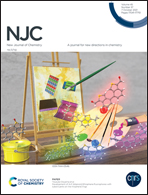Design and synthesis of benzyl aminocoumarin and its anti-Alzheimer's activity†
Abstract
Benzylaminocoumarin is a kind of compound with coumarin skeleton and benzylamino side chain structure at positions 3 and 4. Our group has previously explored the AD activity of 3-(4-aminophenyl) coumarin and obtained benzylaminocoumarin by further structural modification of benzamide side chains. A total of 29 benzylaminocoumarins were synthesized, and the compounds were tested for anti-AD-related activities, and compounds M3, M11, M21 and M26 were found to show good AChE inhibitory activity by in vitro activity experiments, with compound M11 (IC50 = 0.068 ± 0.04) showing better AChE inhibitory activity than the positive drug donepezil (IC50 = 0.079 ± 0.008). The compound showed good MAO inhibitory activity against M3 and M11, of which compound M11 (IC50 = 6.312 ± 0.03) showed the best MAO-B inhibitory activity, but was weaker than the positive drug donepezil (IC50 = 1.697 ± 0.01). The experimental results showed that compounds M21 and M26 could selectively inhibit the AChE activity, and their probability of producing toxic side effects was low. Compound M11 shows dual AChE and MAO inhibitory activity and can be used as a potential therapeutic agent for the treatment of AD. In anti-AD multitarget drug research, multitarget inhibitors have low limitations and are able to produce better therapeutic effects on the entire disease system.



 Please wait while we load your content...
Please wait while we load your content...